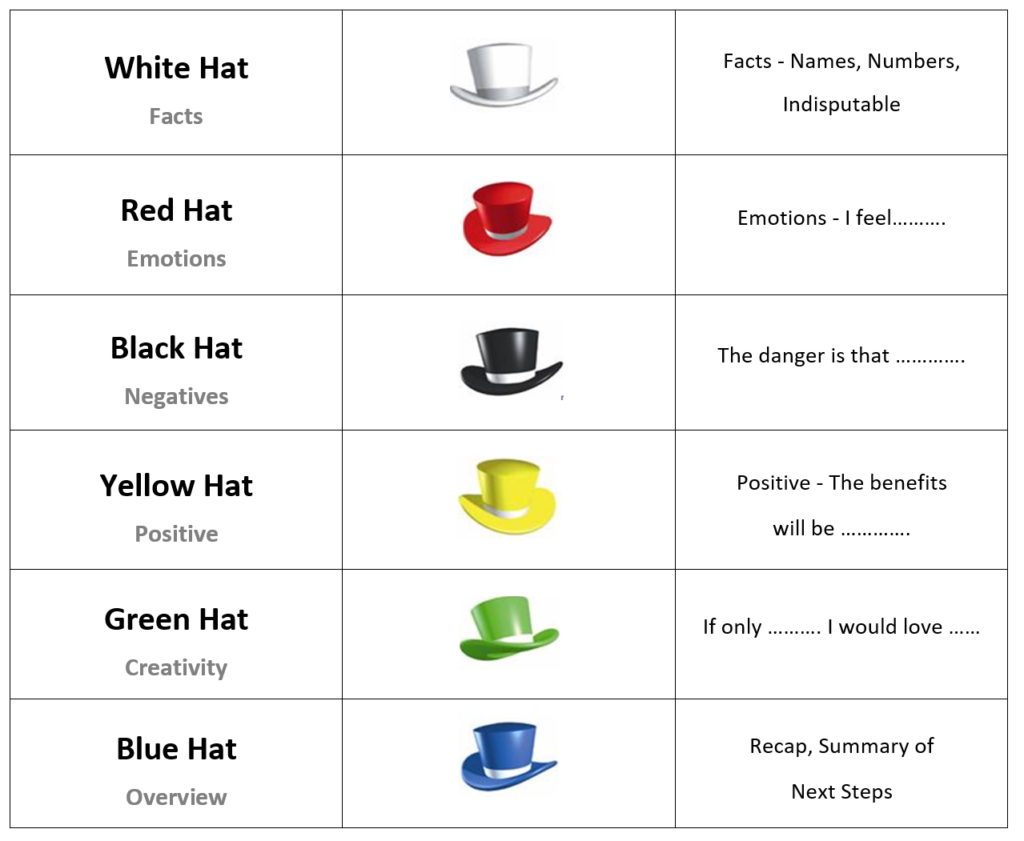Introduction
The Six Thinking Hats innovative brainstorming technique, developed by Edward de Bono, is an interactive, collaborative team exercise that provides a structured framework for successfully conducting group creative-thinking and decision-making activities. This creative technique builds off the conventional notion of “putting on your thinking hat” with the use of six different “Hats” that supports brainstorming, by exercise participants, including thinking filters that represent a focus on facts, emotions, negatives, positives, creativity, and summarization elements.
The key benefit of the technique is to have a group of brainstorming participants examine differing points of view, based on six different directions, for the specific issue or opportunity in parallel.
The technique’s underpinning is that the human brain thinks in several distinct ways that can be challenged and planned for use in a structured manner supporting one to develop tactics for thinking about real issues and potential solutions.
The six distinct directions, represented by the Six Hats, challenge the brain during the brainstorming session. In each of these directions, the mind will generally identify and bring into conscious thought certain facets of the views (e.g., gut instinct, pessimistic judgment, neutral facts). None of these tracks is an entirely natural way of thinking, but rather how some of us already represent the results of our thinking.
“Creative thinking – in terms of idea creativity – is not a mystical talent. It is a skill that can be practiced and nurtured.”
Edward de Bono
Six Hats: Descriptions
The Six Hats are as follows.

Six Hats: Technique Steps
The Six Hats technique improve brainstorming by empowering participants to think in parallel, with one another, and sharing the same framing Hat filters as an alternative to a discussion based on quick feedback and opposition.
The use of the Six Hat Technique is as follows:
- Select one participant as a facilitator for the brainstorming session.
- Provide Brainstorming Worksheet with descriptions of Six Hats to each participant.
- Appoint one (or more) participants a Hat Role.
- Determines order to use the Six Hats by the selected participants.
- Identify Problems or Opportunities to brainstorm within the brainstorming session.
- Agree a time limit for each Hat. Times can vary from 5 minutes to 15 minutes or longer per Hat.
- Brainstorm by each Hat participant(s). Red Hat (Emotions) is typically less time because it’s about automatic responses. The Green Hat (creativity) generally is longer because it is about possibilities, alternatives, and new ideas.
- Form linkages between the information gathered for each Hat.
- Gather and record thoughts expressed from participants wearing the six individual Hats on Worksheet provided.
- Evaluate possible answers and solutions by consensus of the participants with the six hats as recognized filters.
“Creativity involves breaking out of established patterns in order to look at things in a different way.”
Edward de Bono



0 Comments